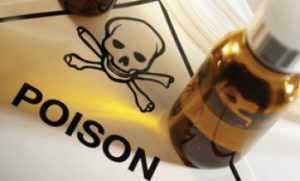From The Vault: Swine Flu School Epidemics: Air Toxicology-The SARS Epidemic & Industrial Poisons

Source: http://www.whale.to/a/west.html
by Jim West
June 2010
http://townsendletter.com/June2010/swine0610.html
Dedicated to Nicholas Regush, ABC News1
This article is reprinted with permission from Jim West.
Chemical and Viral Symptoms
London Smog Coverup
Heat Wave Epidemics
SARS
New York Avian Mortality
Epicenter 1: St. Francis Prep School
Area Pollution
St. Francis: A Ballpark Study
Stressors Summed
Random Stressors
Wind speed: Slow.
April 23, 2009: Epidemic Apex
Wind Vector Study
Wind Patterns 3–4 a.m.
Wind Patterns 8–9 a.m.: Satellite View
Wind Before vs. During
NYCDOH Bar Graph. A Classic Epidemic
Nurse Interview
NYCDOH Questioned
AIRNow Pollution Maps and Spring Break
Related Case
Epicenter 2: Rye School (Westchester, New York)
Epicenter 3: Deer Park Schools
Discussion
This article argues for mandatory air pollution review during flu diagnoses. It also argues that public perception of air pollution is minimized for reasons of industrial economics and politics, by way of laws, rules, education, mainstream news, and paradigm promotions embedded in entertainment.
Flu is nearly always considered viral, as evidenced by a search of the CDC (Centers for Disease Control) website, the New York Times, or any media. Medical campaigns vaccinate millions worldwide, purporting to protect against flu epidemics, yet the symptoms of viral flu are the same as those of toxicological flu, and flu epidemiology makes toxicological sense.
The omission of air pollution from flu diagnostics is a “mistake,” according to Wikipedia, with respect to carbon monoxide poisoning: “Carbon monoxide is the most common cause of poisoning worldwide, often mistaken for a viral syndrome such as influenza.”2
Carbon monoxide (CO) serves as a good example for this commentary because it is well documented and commonplace. CO is just one of many toxic exhaust components emitted by internal combustion engines.3
Chemical and Viral Symptoms
According to the journal Occupational Health and Safety: “Carbon monoxide’s effects are similar to flu symptoms, including dizziness, headaches, disorientation, visual disturbances, nausea, and fatigue.”4
Maimonides Medical Center: “These symptoms include, headache, nausea, vomiting, dizziness, fatigue.”5
Both so-called viral flu and chemical flu can cause severe neurological disease and death. There are few diseases that engine exhaust cannot cause, from chronic and acute exposure.6
Vehicular exhaust contains thousands of components, many of which are toxic; for example, carbon monoxide, formaldehyde, MTBE (methyl tertiary-butyl ether), acrolein, toluene, aldehydes, sulfur dioxide, sulfuric acid, hydroperoxyl radicals, benzene, arsenic, hydrogen cyanide, nitropyrenes, polycyclic aromatic hydrocarbons (PAHs), methane, phenol, 1,3-butadiene, phenol, ethylene, methane, NO, NO2, and acetaldehyde.7
Given that air pollution disease is “often mistaken for a viral syndrome,” how often does this mistake occur?
Dolan et al. performed a hospital study to determine the frequency of this error. They reported:
“No patient with a carboxyhemoglobin level greater than or equal to 10% [i.e., indicative of subacute CO poisoning or greater] was diagnosed as having CO poisoning. …” (They were all diagnosed with viral flu.)
“[T]he literature is well supplied with reports of patients with subacute CO poisoning who were misdiagnosed as having [virus] influenza and sent home with disastrous consequences.” (Disaster also strikes before being sent home.)
“Physicians must seek out the possibility of CO toxicity in patients with flu-like illness. … Physicians must … correctly diagnose patients and avoid a return to a hazardous environment with potentially fatal consequences.”8
In a study titled “CO Poisoning: An Occult Epidemic,” by Sadovnikoff et al., we find a useful diagnostic rule: “Carbon monoxide poisoning must be considered when two or more patients are similarly or simultaneously sick.”9
In late April 2009, as the swine flu epidemic emerged in New York City, Charles D. Connor, president and CEO of the American Lung Association, was quoted in a press release: “Six out of 10 Americans live in areas dirty enough to send people to the emergency room, to shape how kids’ lungs develop, and even dirty enough to kill.”
Historical Precedent. Governments appear to have sponsored the interpretation of severe flu epidemics with industrial bias.
London Smog Coverup
The Great London Smog Coverup, described by Paul Brown, Environmental editor for the UK Guardian10:
To cover up the true extent of the smog disaster the government invented a [viral] influenza epidemic. In fact research has shown there was no epidemic and that the thousands more people who continued to die for the next four months did so because of the air pollution. … Devra Davis, honorary professor at the London School of Hygiene and Tropical Medicine … blames Harold Macmillan, then minister for housing, for suppressing the truth about dirty coal. A later claim by the Ministry of Health that 5,655 had died of [viral] influenza in the first three months of 1953 was a fabrication to hide the smog deaths. …
Tim Williamson (National Society for Clean Air) then draws the parallel to the contemporary petrochemical industry and its mobile exhaust outlets, motor vehicles: “Now there are 28m vehicles, 85% of them cars. … We have defeated one problem only to create another, and [this government] has yet to come to terms with the problem.”
Heat Wave Epidemics
Causation for seasonal, summer mortality is often advertised as “heat waves” in cities like Pittsburg, Chicago, and New York. Meanwhile temperatures can be 30° higher in Phoenix without any “heat wave” mortality.
In 2003, a great heat wave epidemic struck Europe, mostly in France. Causation was advertised widely as a heat wave. Much later, brief press releases mentioned that some scientists believed that this epidemic was due to air pollution. For example, on Sept. 1, 2003: “PARIS (Reuters) – Air pollution may have been the cause of death for thousands of French people who died in a heat wave that struck Europe this August, an environmental official said. …”
SARS
Severe Acute Respiratory Syndrome (SARS) has obvious toxicological factors, with its biggest epicenters being downwind from major industrial regions. Hong Kong was a major SARS epicenter, downwind from China’s Guangdong industrial region. Of Hong Kong’s 11 districts, the highest incidence of SARS was found in the district with the highest air pollution. The most intense epidemic occurred in the Amoy Gardens, a high-rise apartment complex. Strangely, most of the cases occurred at floor 10 and above, indicating vulnerability to stratified industrial smokestack pollution. As of a 2002 study, 40% of Hong Kong children suffer respiratory disease; thus, SARS appears to be a new name related to an old ailment. Six months after my SARS study was published by the Weston A. Price Foundation, a study was published by UCLA indicating a high correlation of SARS mortality with air pollution. SARS then left the panic scene, replaced by “Bird Flu.”
New York Avian Mortality
It appears that the “flu-like” West Nile virus epidemics are interpreted with industrial bias.11 In the New York City region, avian mortality reached record high in the years following increases in MTBE concentrations in gasoline in 1994. MTBE is a highly poisonous, unpublicized chemical, mandated into gasoline since at least the mid-1970s, as an oxygenate, purportedly – and disputably – to reduce air pollution. MTBE intensifies the existing toxic characteristics of engine exhausts, increasing levels of methyl nitrite and formaldehyde.
The ban on MTBE was initiated by the EPA (Environmental Protection Agency) on July 27, 1999. That coincided with the apex of the first declared West Nile virus epidemic in the US. This flu-like disease, potentially fatal, is often diagnosed as meningitis and encephalitis. Preceding the human epidemic were findings of dead crows along expressways and bridge outlets.
Initially, the New York State Department of Environmental Conservation (NYSDEC) actually blamed the 1999 avian epidemic on unspecified industrial pollution. About a month after a human epidemic was discovered, the CDC and local New York City Department of Health (NYCDOH) announced a virus epidemic through Mayor Rudolph Giuliani, September 3, 1999. This was highly dramatized in the media with a military-style attack on “the virus,” using helicopters to spray the entire Tri-State Region with the organophosphate pesticide malathion. Four of the five boroughs were sprayed, though not Manhattan, which was fogged by truck. All the while, headlines blared, “The Deadly Virus.” With this overpowering politic, the NYSDEC reversed its presumptive toxicological diagnoses, embraced the virus paradigm, and received funding for virus diagnostics of wildlife.
The geographic epicenter location in 1999 is the same as the swine flu epicenter location for 2009; that is, Flushing Meadows, Queens, New York City.
Swine Flu: Symptoms correlate well with environmental causation, yet the diagnostics lack toxicology. To argue for toxicological diagnostics, environmental factors are presented for US swine flu epidemics, as reported by the media and NYCDOH, beginning late April 2009.
Epicenter 1: St. Francis Prep School
This school epidemic led the swine flu media furor which began in April 2009. This epidemic event represents the highest incidence worldwide for swine flu. The location of this school is Flushing Meadows.
Incidence of flu symptoms spiked on April 23 at St. Francis School (see satellite photo).12 Five days later, the school was closed by the NYCDOH. One-third of students polled responded that they had experienced flu symptoms, and many cases were confirmed by the CDC as swine flu.
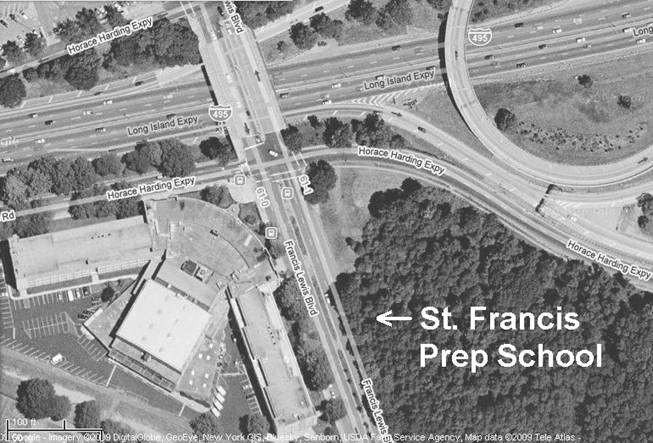
In New York City, there is a tradition of official concern about air pollution, because, for instance, one-fourth of New York City school children have asthma, a disease related to air pollution and, as some researchers have found, neuropathologies. This might explain why, in New York City, it is illegal to idle an engine for more than 60 seconds near a school.13 In the vicinity of St. Francis Prep, engines do much more than idle.
Eighteen lanes of traffic are adjacent St. Francis: Long Island Expressway, Horace Harding Expressway, and Francis Lewis Blvd. If nearby traffic loops and the Clearview Expressway, 1,000 feet to the east, are included, then the total vicinity traffic is at least 30 lanes. These lanes extend as straight lines for miles.
It is important to understand the danger of long, straight lanes. A slow unidirectional wind in line with these straight traffic structures can target any nearby school or residence with high concentrations of vehicular exhaust as wind drifts through the lanes, accumulating and raising toxic concentrations. This scenario is more dangerous during rush hour or pre-sunrise hours when winds can slow and temperature inversions tend to occur.
Note: in this commentary, SUIR stands for Slow, Unidirectional wind, In-line with Rush-hour traffic. This is not an established acronym, but to avoid repetition it is necessary, as a convenient designation for what is an apparently novel concept. Despite its novelty, it is common sense and common experience. For further clarification, see drawing “In-line Worst Case Scenario.”

Another, more conventional air hazard scenario is where slow wind predominantly crosses the traffic lanes at a 90 degree right angle. See “Crosswind Scenario.”
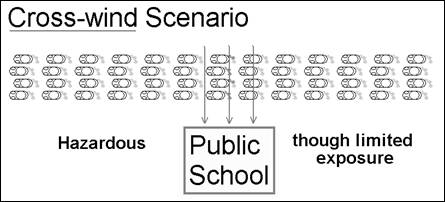
The cross-wind scenario is much less hazardous than the SUIR scenario.
Traditional freeway and expressway air pollution studies generally conclude that after 300 to 500 yards, levels subside to background levels. New studies, however, find this distance to be as much as 1.5 miles during pre-sunrise hours, because of slow winds and temperature inversions that prevail.14
Area Pollution
St. Francis is also exposed to a major airport, La Guardia Airport (LGA), one of the nation’s busiest, situated 5 miles northwest, up the prevailing wind. The airport’s main takeoff lane is directly in line with this school. Airliner turbines drive exhaust downward, mixing with ground-level air to an extent influenced by factors such as air temperature, convection efficiency, wind direction, and speed. One airliner during takeoff and landing is equivalent to a car driving approximately 5,600 miles, in terms of exhaust pollution.15 See map “LGA.”
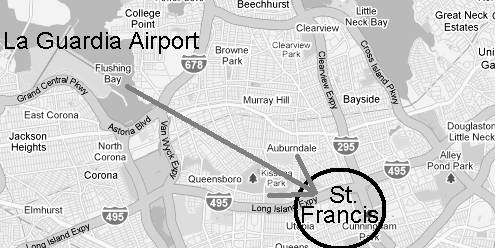
Approximately 19 tons of NOx (toxic nitrogen compounds) per day are produced from La Guardia air traffic, accounting for 1% of New York City’s total NOx production. Though LGA is miles away, its airliners can affect ground level until they reach approximately 3,000 feet altitude. Prevailing winds are northwest, thus moving a continuous expanse of LGA pollution across Queens.16 Regionally, 70% of US air carrier aircraft travels through the New York City airspace, including Newark Airport, New Jersey.17
St. Francis: A Ballpark Study
Pollution data are not available in the immediate vicinity of St. Francis. There is no comprehensive air monitoring system on site. Regional and area data are available; for example, EPA ozone maps, weather data, and general studies of symptoms and dosage observations. These are valuable data sources yet not sufficient to understand the toxicological plight of St. Francis.
It is possible, using CO literature, to compare dosage and effects of the CO component of vehicular exhaust. This comparison places St. Francis within the hazard ballpark. See table, “Ballpark Evaluation.”
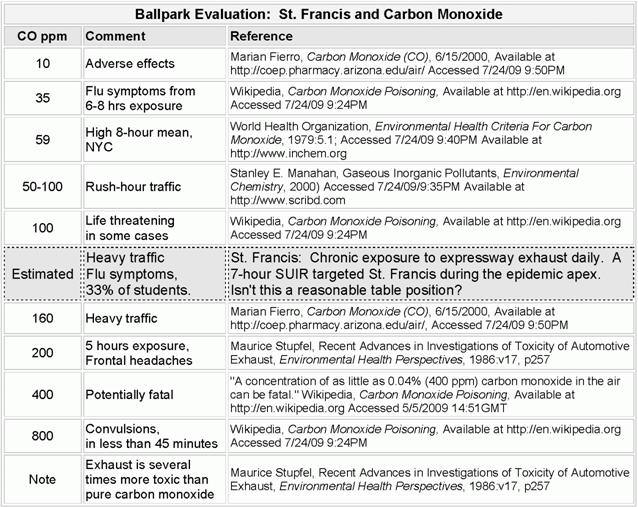
Stressors Summed
Disease can be conceptualized as symptoms resulting from the sum of stressors and stressor synergies. Air pollution stressors behave as constants and variables. They can be categorized as global, regional, local, adjacent, or internal to a building. Global, regional pollution is slow-changing, and relatively constant. Local and immediate pollution can be more variable. Airport pollution is a relative constant burden, though dependent on wind characteristics. Expressways are a local variable, always an extreme potential hazard, and variable exposures are dependent upon wind direction and speed. Air temperature inversions are a variable.
Random Stressors
Random, short-term air pollution attacks on a specific location are beyond the ability of EPA to publicly predict. Numerous constant and variable stressors can coincide at a specific location to create a disastrous sum of toxic stress, resulting in disease. The NYDEC, NYDOH, and CDC are aware of stressor probabilities for high-risk zones, because they run detailed models, taking days of computer time to determine worst-case scenarios. That could explain why expressway speed limits in the New York City area are mysteriously limited to 55 mph, though originally designed for 75 mph traffic. Thousands of people reside, study, work, and are transported near or within expressways. The slower speeds cut the volume of exhaust emissions in half, lessening the regularity of occurrence for the more obvious epidemics.
Local weather, as a random coincidence of hazardous variables, is of the greatest importance. Such variables can change per minute or per second, from benign to acute – benign if the wind is blowing away from the target, and acute during a perfect SUIR. Basically, there are four weather factors that contribute to a SUIR.
Wind speed: Slow.
Wind direction: In-line with adjacent LIE expressway traffic (not merely cross-wind). Unwavering, unidirectional, source to target. A highly directional plume.
Temperature inversion: Usually, warm exhausts move upward via convection into cooler upper layers. During an inversion, air strata temperatures are reversed, with warmer layers on top of cooler layers at ground level. Exhaust moves up through the lower cool layers, absorbing that coolness, and then upon encountering an upper (but low level) warm strata, convection is halted. The phenomena depends on other factors such as turbulence and layer location and structure. Inversions are common in pre-sunrise hours.
Warm seasonal air temperatures: This can lower the efficiency for upward convection of warm exhausts.
April 23, 2009: Epidemic Apex
The epidemic apex at St. Francis began on April 23, as many students began lining up outside the nurse’s office at approximately 9:30 a.m. They continued to line up throughout the rest of the day. A total of 102 students were sent home that day. This was very unusual, prompting the school nurse to call the NYCDOH at 10:30 a.m.
Two excerpts from CBS News18:
“More than 100 students at St. Francis Preparatory School in Queens were suddenly hit with fever, sore throat and other aches and pains.
“‘I just saw lot a lot of kids lined up along the wall near the nurse’s office,” sophomore Kelsey Dittmeir said.'”
The New York Times, April 28, 2009: “By 10 a.m., dozens of students were pouring into the hallway outside her office, sitting miserably on the floor, nauseous and confused.” The nurse called Dr. Gary Krigsman, who referred her to the CDC’s Ada Santiago. One hundred and two students were sent home by the nurse on Thursday, and 80 on Friday.19
With such suddenness, questions must be asked: Is this a replicating virus, spreading upon contact from a few people (6 of over 2,500 students) who returned with an assumed infection from Mexico? Or is this a sudden increase in air poisoning? Students suddenly became ill at school during an unusual period of intense air pollution specific to the school. Why did the NYCDOH narrowly assume the virus paradigm?
Environmental studies provide alternative answers.
Wind Vector Study
Coinciding with the epidemic apex is a set of unusual wind patterns, bringing high concentrations of expressway pollution to bear on St. Francis, as a SUIR scenario for 12 unrelenting hours.
Wind patterns for the epidemic apex (April 23) have been studied in detail with Wvect software.20 See satellite photo “Wind Patterns 3–4 a.m.,” where, for clarity, only wind patterns passing through St. Francis are designated.21 This reveals a dramatic steady focus of expressway pollution into the school, saturating its structure before school hours, and throughout the school day, from 12am to 12pm.
Wind Patterns 3–4 a.m.
Satellite View
Such wind patterns continued for 12 hours, from 12am through the school morning. For example, see satellite photo, “Wvect 4/23 3–4:00am,” with winds from the northwest.
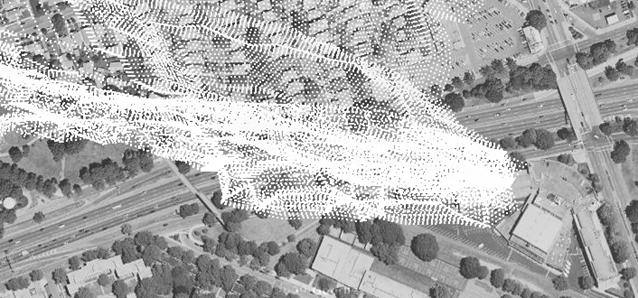
Wind Patterns 8–9 a.m.: Satellite View
By 9 a.m., the classes had been in session for 70 minutes. Wind patterns are shown for the period 8–9 a.m. These wind patterns continue into the afternoon, with some increasing dispersion after 11am. See satellite photo, “Wvect 4/23 8–9:00am,” with winds from the northwest.
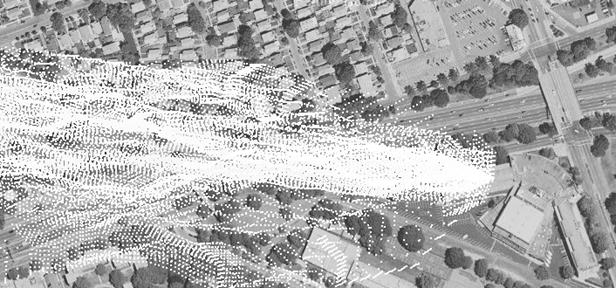
Wind Before vs. During
April 22 vs. April 23
The DAY BEFORE THE EPIDEMIC APEX (Wednesday, 4/22), few wind patterns cross traffic lanes towards St. Francis. There also are no usual number of visits to the nurse’s office.
Compare the two traffic maps for St. Francis, “Wind Pattern Study, April 22nd” and “Wind Pattern Study, April 23rd” and note the wind pattern differences.
Note that on the DAY OF THE EPIDEMIC APEX (Thursday, 4/23), all wind patterns cross traffic lanes towards St. Francis, usually as a perfect SUIR.
NYCDOH Bar Graph22
A Classic Epidemic
The NYCDOH produced a bar graph, “Date Of Illness Onset Of St. Francis Students,” by polling students, asking for dates of perceived flu symptoms. The poll was finalized six days after the epidemic breakout. The NYCDOH compiled the poll in the midst of dramatic media publicity.
This graph fits the publicized image of six virus-infected students returning from Mexico on April 20, after spring break. See the bar graph “Date of Illness Onset.”
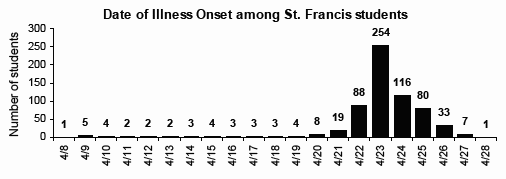
The NYCDOH’s data-gathering and evaluation were highly subjective. The symptoms reported by students after April 23 can be reasonably expected, due to fear induced from massive media hype, which occurred after the 23rd. Residual symptoms from that date would also be perceived as more serious due to the media hype. Students would be encouraged by parents to claim symptoms to avoid class as a precaution against supposed virus infection. The presence of the questionnaire itself is a bias factor.
The NYCDOH chose not to use objective data, recorded at the nurse’s office. Prior to April 23, the nurse had recorded data without presumptions, without knowledge of the impending epidemic. Her records resolve the contradictions established by the NYCDOH’s bar graph and the wind vector studies.
The nurse was interviewed to discover actual visits and activity at her office, recorded before, during, and after the epidemic apex.
Nurse Interview
Critical data acquired during the nurse interview confirm the wind studies and contradict the NYCDOH graph.23 The nurse stated that there were absolutely no unusual number of visits to her office, no unusual activity, in the week prior to the April 23 outbreak; that is, since April 20, when the six students returned from Mexico.
She also stated that, to the best of her knowledge, there was no environmental testing on or after the 23rd, regarding, for example, ventilation system, painting, floor surfacing, expressway, or gases. When asked if the omission of environmental studies was “because the epidemic was viral?” she replied, “Yes.” The nurse gave counts for students sent home on April 23 and 24, which confirmed counts already public information. She speculated as to why her records prior to April 23 did not conform to the NYCDOH poll, stating that symptoms may have been too low level for students to visit her office. See “NYCDOH Graph Comparison.”
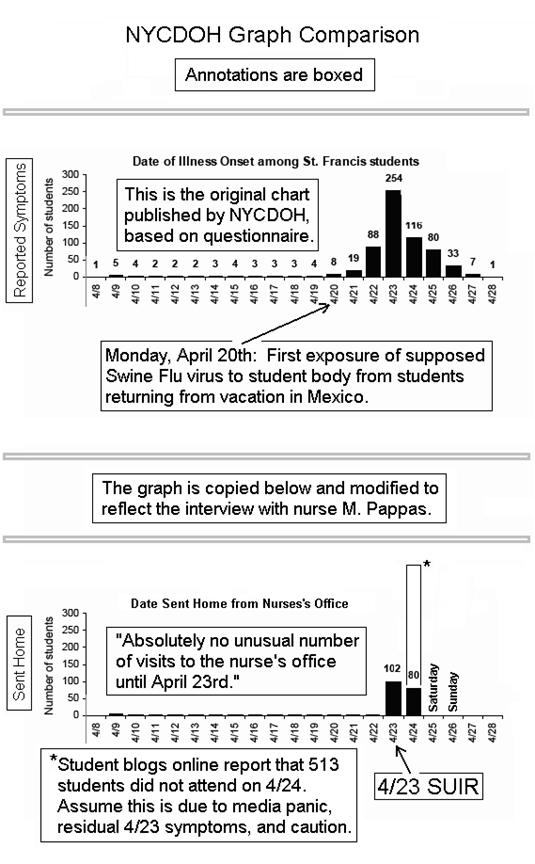
The NYCDOH’s graph dramatizes the virus theory by showing a classic logarithmic rise in number of flu symptoms beginning on April 20, when the six students returned from Mexico vacation, presumably infected.
Further information was requested from the nurse’s office. No response. The NYCDOH is known to keep a tight rein on communications.24
NYCDOH Questioned
To understand toxicological avoidance, I posed a simple question on the NYCDOH Swine Flu Forum (June 24, 2009).25 This forum was managed by Dr. Susan Kansagra, who “worked on the Health Department team that’s responding to this outbreak.”
Question: “Is the flu investigation team reviewing air pollution at the closed schools?”
Dr. Kansagra replied, unusually off-topic, “Like all flu viruses, H1N1 virus is spread mainly through respiratory droplets when an infected person coughs or sneezes.”
The question was repeated. The forum was closed.
Usually, questions were answered within 20 minutes to three hours. In this case, Kansagra’s off-topic reply and forum shutdown arrived two days later. The original question had been passed up in favor of answering others, until the off-topic reply.
The closing of forums is not unusual, along with censure, bans, top-down declarations of “fact,” and ad hominem arguments.
AIRNow Pollution Maps and Spring Break
I had noticed there were few symptoms reported by the NYCDOH poll during the second and third week of April, yet area pollution readings were high according to the averaged AQI levels shown by EPA AIRnow maps. To understand this contradiction, I referenced the New York Department of Education and found that there was no spring break at that time. This was puzzling. Later, I found that St. Francis, being a Catholic school, was not following the New York City calendar, and had indeed been on spring break, thus conforming to the air pollution theory.
Related Case
Details of this case need confirmation, because it concerns an individual, where data is difficult to obtain and difficult to describe due to privacy ethics. Years ago, a rare case of flu, severe enough to be highly publicized (though with scant detail), occurred in the New York City region. At that time, I had noted this case for future study. While gathering data for this current paper, I found that the victim was hospitalized while apparently attending St. Francis Prep during a SUIR, with diagnostics and antibiotic treatments immediately preceding an severe acute disease episode. This victim was already mildly ill and possibly already undergoing pharmaceutical treatment when the acute symptoms suddenly appeared.
Epicenter 2: Rye School (Westchester, New York)
This school was reported secondly in the New York regional media, and nationally this epidemic vied for attention with the emerging Texas swine flu news. See photo-map “Rye School.”
Only four cases were confirmed as swine flu. The school was scheduled to close on May 5, 2009, apparently because administrators were influenced by the heavy St. Francis publicity and because one Rye School student had the week before arrived from a visit to Mexico and became ill with mild flu symptoms on April 27, 2009.
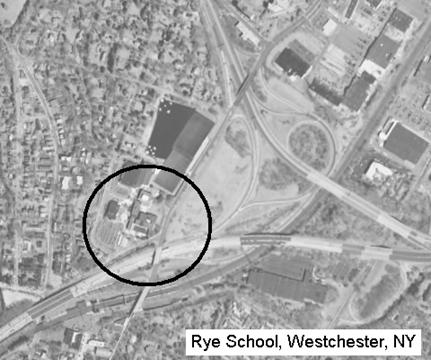
On that day the wind was from the two expressways. The average wind speed was very slow, one of the slowest of the month, averaging 2.7 mph during the school hours.
A wind plume map has been depicted as a series of wind vectors from the school. This reveals a SUIR, though not as unwaveringly focused, nor as close to the pollution sources, as the St. Francis SUIR. Accordingly, there were not as many cases of flu symptoms during the period circa April 27. See photo-map “Rye School : Wind Direction Vectors.”
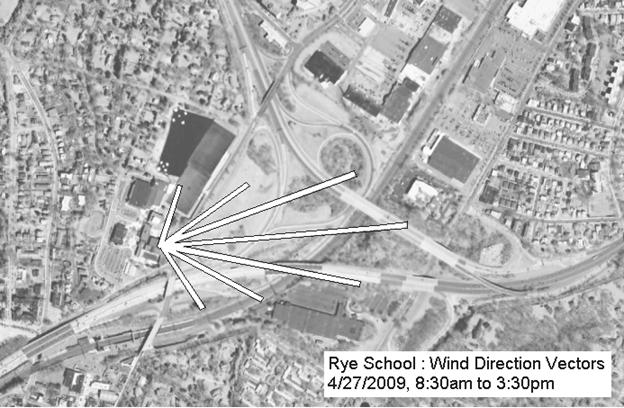
Epicenter 3: Deer Park Schools
JFK Intermediate School, in Deer Park, Long Island, New York; five cases suspected swine flu (marked “A”). Deer Park Union Free School, in Deer Park, just south of JFK Intermediate School. 3 cases suspected swine flu. Closed May 3, 2009
These schools are not adjacent to expressway traffic. However, seven expressways lie as a perimeter around the schools at 2 to 3 miles’ distance. These could not easily account for a sudden onset of flu symptoms. A contradiction looms.
Assuming expressway pollution at this distance is a somewhat constant low-level exposure, and assuming virus = biomarker for poisoning, then further study resolves contradictions, finding a source of air pollution approximately 200 feet east of the school border; that is, a major Superfund site and ongoing industry. Contaminants include, for example, chlorines, xylenes, and benzenes. During prior years, 50,000 tons of soil was “remediated,” which means toxins discharged to the atmosphere. Current status of operation is difficult to determine but it appears that clean-up operations are now minimal.
The EPA lists only one of these Superfund sites as possibly active, SMS Instruments Inc.
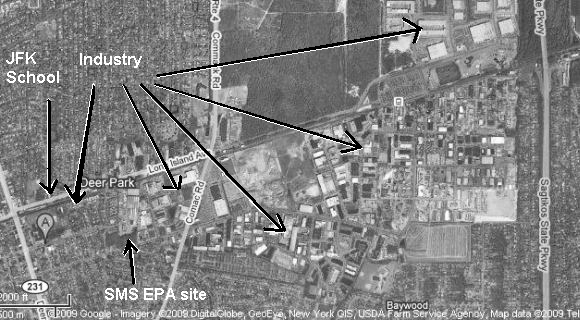
EPA Site Description: “SMS Instruments, Inc. is located in a light industrial area in Deer Park. The site consists of a one-story 34,000-square-foot masonry building on 1-1/2 acres. Approximately 80% of the lot is paved with asphalt. From 1971 to 1983, SMS Instruments, Inc. overhauled military aircraft components. Industrial wastes generated from degreasing and other refurbishing operations were discharged to a leaching pool on site. In addition to the leaching pool, other sources of contamination included a 6,000-gallon underground storage tank used for jet fuel storage and corroded and leaking drums stored outdoors in an unprotected area. More than 50 industrial facilities are located within a 1-mile radius of the site, and a large groundwater recharge basin is located adjacent to the eastern side of the site.”26
Discussion
Other school epidemics have been reviewed with similar findings that argue for toxicological diagnostics. The supposed global epicenter at La Gloria, Mexico, was also reviewed and found to have obvious toxicological factors. With every review of any epidemic or case, findings vary; that is, toxicological modes and events vary, yet there is an ease with which data sensibly fall into place. The toxicological argument is slowed by data blockage and Orwellian definitions; otherwise, the toxicological argument always benefits from more data.
The toxicological approach sets the foundation for a general toxicological theory of disease where Occam’s razor thrives. Patients as well as medical people are encouraged to demand environmental reviews as essential protocol, and to look skeptically at any paradigm that does not include a full toxicological review. All diagnostics should be moot unless pollution and pharmaceuticals are fully discounted.
Disease symptoms themselves are freely available indicators of environmental hazards, and they have no conflict of interest with chemical industries. They are the ultimate indicators. Relevant new ideas and information often arrive by focusing on the possibilities of air pollution as revealed by timeline analyses of symptoms. A tremendous variety of symptoms, too many to list here, can be bioindicators of low-level, chronic air poisoning, or brief acute poisoning, which are below the threshold of technical detection, or out of the scope of politicized technical detection. The symptom is the bottom line. This informal toxicology can be confused and complicated by nutritional ignorance, chlorinated-fluorinated water, pesticides, pharmaceuticals, cigarettes, caffeine, and alcohol. Fewer toxicological variables means simpler and more successful diagnostics.
One could argue forever about germs and whether they are symbionts or pathogens. It is most effective to simply leave the burden of proof where it belongs, on those who claim germ causation. They must be routinely confronted with the simple position that all claims for germ pathology are moot until toxicology is discounted. A single question is challenging enough: “Why is toxicology omitted?” Many areas of medical expertise can be effectively challenged with that question; for example, microbiology, diagnostics, and epidemiology.
The process of selecting schools for this study was unbiased. The first three school swine flu epicenters announced by mainstream media in 2009 were studied. Many other schools in the New York City area have also been studied.
These studies are based on previous work: Polio and Pesticides (1997), West Nile Virus Epidemics and Air Pollution (1999), SARS and Air Pollution (2001), Bird Flu and Air Pollution (2004), and discussions with NoSpray Coalition, NYC.27-32
For guidance, editorial support, and technical contributions, many thanks to Sheri Nakken, Gary Krasner, Ramiel Nagel, and John Scudamore.33-36
The intent of this commentary is literary, critical, and academic, for discussion. An ethical medical professional should be consulted regarding medical issues.
![]()
©HARpub 2009, Jim West – All Rights Reserved
Jim West served as chairman of the Science Committee for NoSpray Coalition, which successfully litigated (2000–2007) against the Giuliani administration (NYC) regarding pesticide spray campaigns. He is a member of GreenSpeakers, Toastmasters, and ARAS (Canada). He studied mechanical and chemical engineering at ASU, and has resided in New York City for the past three decades. Contact information: [email protected].
![]()
Notes
1. Regush, N. Virus or environment. ABC News. Aug. 29, 2001. http://abcnews.go.com/Health/story?id=117258&page=1. Accessed Dec. 7, 2009.
2. Carbon monoxide poisoning [web page]. Wikipedia. http://en.wikipedia.org/wiki/Carbon_monoxide_poisoning. Wikipedia. Accessed July 20, 2009.
3. Krivoshto et al. The toxicity of diesel exhaust: implications for primary care. J Am Board Fam Med. 2008;21(1):55–62. Available at: http://www.jabfm.org/cgi/content/full/21/1/55. Relevant extracts: “Diesel exhaust is 100 times more toxic than gasoline exhaust, even when carbon monoxide is considered” and “gasoline exhaust, which contains 28 times more carbon monoxide than diesel exhaust.” Accessed Dec. 7, 2009.
4. Gabrielse D. Play it safe with engines. Occup Health Saf. http://ohsonline.com/Articles/2009/01/01/Safe-with-Engines.aspx, Accessed July 20, 2009.
5. Carbon monoxide poisoning [web page]. Maimonides Medical Center. Available at: https://www.maimonidesmed.org, Accessed July 20, 2009.
6. Carbon monoxide poisoning. Wikipedia.Op. cit.
7. Diesel exhaust particulates reasonably anticipated to be a human carcinogen. In: National Toxicology Program. Department of Health and Human Services. Ninth Report on Carcinogens. 2000. Available at: http://ntp.niehs.nih.gov/ntp/roc/eleventh/profiles/s069dies.pdf. Accessed Dec. 8, 2009.
8. Dolan MC, Haltom TL, Barrows GH, Short CS, Ferriell KM. Carboxyhemoglobin levels in patients with flu-like symptoms. Ann Emerg Med. 1987;16 ISS7:752–756.
9. Sadovnikoff N, Varon J, Sternbach GL. Carbon monoxide poisoning. An occult epidemic. Postgrad Med. 1992;4:15;86–88,92–96.
10. Brown P. 50 years after the great smog, a new killer arises. Guardian. Nov. 30, 2002. Accessed July 18, 2009.
11. West J. West Nile virus positives and MTBE. Townsend Lett. 2002;228:64–76.
12. Google Maps online: All satellite photos and maps.
13. Council of the City of New York. Council votes to toughen engine idling restrictions near city schools. PR005-2009. Jan. 28, 2009.
14. Hu S. A wide area of air pollutant impact downwind of a freeway during pre-sunrise hours. Atmos Environ. 2009;43:2541–2549.
15. Transportation facts [Web page]. Coalition for Clean Air. http://www.coalitionforcleanair.org/our-programs-transportation-facts.html. Accessed July 20, 2009.
16. West J. Geography: toxicology and WNV encephalitis. http://www.harpub.co.cc/noxot/epidGeog.htm. Accessed July 20, 2009.
17. House Transportation and Infrastructure Subcommittee on Aviation. Statement by Louise E. Maillett, Acting Assistant Administrator for Policy, Planning And International Aviation, Federal Aviation Administration, Department of Transportation. Dec. 5, 2000. Available at:http://testimony.ost.dot.gov/test/pasttest/00test/Maillett2.htm. Accessed Aug. 1, 2009.
18. Carlin D. Confirmed: swine flu outbreak at Queens school [Web article]. CBS Broadcasting. April 29, 2009. http://wcbstv.com/health/swine.flu.nyc.2.994071.html. Accessed December 7, 2009.
19. Hartocollis A. School nurse’s response to flu wins applause. New York Times. April 28, 2009.
20. Wvect software, engineered by MaguSoft.
21. All maps are Google Maps: http://maps.google.com.
22. New York City Department of Health and Mental Hygiene. St. Francis Prep update: swine flu outbreak: Survey Monkey results. Available at: www.nyc.gov/html/doh/downloads/pdf/cd/h1n1_stfrancis_survey.pdf. Accessed Oct. 3, 2009.
23. Harvey E. Interview of Nurse Mary Pappas, of St. Francis Prep. Sept. 18, 2009. Transcription.
24. In 2001, Nicholas Regush of ABC News attempted to contact NYCDOH regarding air pollution and West Nile virus epidemics. The press office interrogated him at such length that he told them, “I’m supposed to be interviewing you, not the other way around!” NYCDOH did not respond for interviews. Personal communication.
25. Kansagra S. H1N1 flu. nycHealthy [blog]. http://pulse.typepad.com/nychealthy/2009/05/dr-susan-kansagra-h1n1-flu.html. Accessed July 20, 2009.
26. SMS Instruments. EPA Region 2 [online document]. Available at: http://www.epa.gov/region2/superfund/npl/0201325c.pdf. Accessed Jan. 4, 2009.
27. West J. DDT/Polio. New York; HARpub; 1997
28. West J. Images of poliomyelitis – a critique of scientific literature. Townsend Lett. 2000;203:68–75.
29. West J. West Nile Virus positives and MTBE. Townsend Lett. 2002;228:64–76.
30. West J. The SARS epidemic: are viruses taking the rap for industrial poisons? Wise Traditions. Dec. 7, 2003. Available at: www.westonaprice.org/envtoxins/sarsepidemic.html.
31. Rappoport J. Has Jim West turned conventional knowledge about bird flu upside down? No More Fake News [blog]. http://www.nomorefakenews.com/archives/archiveview.php?key=2961. Accessed Dec. 7, 2009.
32. NoSpray Coalition. http://nospray.org. Coordinator, Mitchel Cohen, chairman of the NYC WBAI board.
33. Sheri Nakken, RN; director, Vaccination Information & Choice Network: http://www.wellwithin1.com/vaccine.htm.
34. Gary Krasner, director of Coalition For Informed Choice (CFIC), Queens, NY: http://www.cfic.us.
35. Rami Nagel, author, researcher, consultant on medical alternatives: http://www.healingourchildren.net.
36. John Scudamore, curator of an online collection of medical investigations: http://www.whale.to.
The SARS Epidemic: Are Viruses Taking the Rap for Industrial Poisons?
By late May, officials had reported over 8,000 cases worldwide, with almost 700 deaths.1 Of the 65 suspected SARS victims in the US, all but a few had traveled by airplane to areas where the outbreak has been most severe, including mainland China, Hong Kong, Singapore, Hanoi and Toronto. The Chinese economy has taken a hit and some Chinese airline routes were virtually empty due to SARS fear.2
Serious Drama
The SARS outbreak has revived discussion of forced quarantine. According to a study by the American Public Health Laboratory Association and quoted by Senator Edward M. Kennedy, Democrat of Massachusetts, few cities have enough hospital space to quarantine patients in the event of a large-scale outbreak of an infectious disease like SARS. According to Lawrence O. Gostin, director of the Center for Law and the Public’s Health at Georgetown University’s Law Center, public health laws date back to the 19th century and are “wholly inadequate to deal with an emergency.”
“The need for public health law reform is urgent,” said Mr. Gostin. “It should have provisions for surveillance, vaccination, treatment, isolation and quarantine in a way that gives decisive powers to health authorities while respecting the Constitution.” So far, all but one of the SARS victims has submitted to voluntary isolation. The one exception, a New York man, was involuntarily contained until his symptoms passed. Federal quarantine law now includes SARS among its disease guidelines.
Mr. Gostin was the author of the draconian Emergency State Health Powers Act, which has been adopted (fortunately in softened form) by 22 states. According to Gostin, “The need for effective state compulsory power is beyond doubt. But that’s not a given in our country, which is now so tied to the rhetoric of individual rights. It seems we’ve lost the tradition of the common good.”3
Kill The Carrier
In China, a country where the “rhetoric of individual rights” is lacking, the government has announced it would kill SARS carriers who refused quarantine.4 Malaysian officials threatened imprisonment.5 In Hong Kong, officials motivated by the “tradition of common good” have suggested that “families of SARS patients be rounded up, and sent to quarantine camps.”6 In Nanjing, China, 10,000 have been quarantined, and in Beijing 16,000 as of May 6, 2003.7
Official Disease Definition
SARS means “Severe Acute Respiratory Syndrome.” This wide-open definition encompasses many diseases common in the affected regions. Symptoms range from flu-like to pneumonia.8 Dr. Frank Plummer, director of the National Microbiology Laboratory in Canada stated, “Of course, the case definition of SARS is a little loose.”9
The World Health Organization (WHO) has defined SARS in the following way: a) a person presenting after 1 November 2002 with history of high fever (greater than 100.4° F) and cough or breathing difficulty; or b) a person who was not autopsied but with acute respiratory disease and who has been in close contact within 10 days of someone who had SARS.10
This definition alone should give thoughtful readers cause to question the SARS phenomenon. Firstly, is a temperature of 1.8 degrees F over normal really a “high fever”? The CDC used “mild fever” in their case definition. Secondly, should WHO install a historical bias before the history of SARS is even written? WHO has made it impossible to place the discovery of SARS before November 2002, or even think of it as preceding that date, thus guaranteeing its status as an “emerging epidemic.”
In the US, the Centers for Disease Control (CDC) defines SARS differently: a) Illness of unknown aetiology [cause not already ascertained] and onset after February 1, 2003, AND, b) Temperature over 100.5 degrees F, AND, c) respiratory illness, AND, d) Recent contact with a SARS patient or travel to epidemic region.
This defines the new epidemic as an arrival from southeast Asia, China or Toronto. This definition obviates any need to test for the SARS virus in patients who contracted pneumonia before February 2003, AND, who had not traveled to the Orient or met such a traveler. With this definition, the diagnosis of any SARS-like case, determined previously to be of non-viral origin, would be secured from contradictions. The usual one-disease, one-cause theme for epidemics is thereby maintained.
SARS Virology
Due to the wide-ranging definition, the only unique quality of SARS is the associated virus. But association is not enough and a single association is not a rigorous, convincing proof.
On April 16, 2003, WHO announced that SARS virus, a member of the coronavirus family, was definitely causative for the disease. The report referred to a study carried out by a team led by Dr. Albert Osterhaus, the director of virology at Erasmus Medical Centre in Rotterdam. Media reports used the terms “unequivocal,” “definite,” and “beyond a doubt” to describe the work at Erasmus.
Osterhaus reported that his team infected one group of monkeys with SARS virus, a second group with the metapneumonvirus (also found in some SARS patients), and a third group with SARS virus and then the metapneumovirus. The monkeys infected with the metapneumonvirus alone developed mild symptoms, compared to the “full-blown disease” seen in the first group. The third group “did not develop a more serious version of SARS.” From this Osterhaus concluded, “the coronavirus alone is capable of causing the typical symptoms…”11
Virology In Doubt
Press releases about the “definitive” Erasmus study, distributed by AP, WHO, Nature Magazine and others, cannot be taken seriously without further details. Here are a few unanswered questions:
a) Since laboratory virus stocks are poisoned with antibiotics, or are derived by a process that utilizes poisons, then which poisons were present in Erasmus University virus stocks?
b) Were the toxicities of virus stocks included in the assessment of the study results?
c) How was the virus stock obtained?
d) Was a comprehensive test for other viruses performed on the experimental stock?
e) Are the laboratory-produced viruses chimeric viruses, that is, synthetic viruses?
f) What quantity of virus medium was applied to each monkey; that is, what multiple of real-world conditions?
g) What concentration of viruses were applied; that is, what multiple of real-world conditions?
h) How was the medium applied; would the application method be possible in real-world conditions?
i) Which chemicals were added to the medium in addition to antibiotics? Do these interact or promote the toxicity of other chemicals in the virus stock?
j) How many monkeys were in each group? Were there enough for a valid assessment?
k) What was the condition of each monkey prior, during and at the conclusion of the experiment? Monkeys have been regarded as poor experimental subjects because of their intelligent sensitivity, and maltreatment received from handlers and distributors. Stress alone, incurred by the monkeys due to cruelty, cage conditions and poor nutrition, can cause illness or susceptibility.
l) Was the virus used in the experiment actually “isolated”? The word, when used by virologists, means something entirely different from the meaning assumed by non-virologists (including doctors), and this word serves as the basis for misinformation regarding virus proof. The details of “isolation of the virus” need to be explained.
m) Were any of the experimental animals, or tests, rerun after unexpected results occurred? What were the circumstances?
At this writing, one further detail of the Erasmus study has been obtained, “Osterhaus and colleagues completed the final ones [Koch Postulates] when they infected two macaque monkeys with the virus from a SARS patient and isolated it from the animals.”12
So, the “definite” proof is based on two monkeys injected with the supposed SARS virus. What happened to independent confirmation, randomized controls, and probability analysis that determine the possibility that a test on two monkeys is valid? The hyped language, the major institutions and funding sources involved, juxtaposed against the meager number of monkeys in the experiment, point to extreme bias in the search for a microbial demon. I look forward to more details of the Erasmus study.
As of late May, tests for the virus in Toronto “failed to spot a targeted virus in 30% to 50% of infected patients.”13 This was attributed to inaccurate testing methods, not the absence of the virus. Nevertheless, no matter how often SARS virus is found, the virus is present only in trace amounts and not in quantities large enough to cause disease, leaving infection and pathology in doubt.14
Convenient Scapegoats
In spite of the nagging inconsistencies in the viral theory for SARS, scientists and the press have gone one step further with reports that SARS originated in a live meat market in China’s Guangdong province in November, 2002. Researchers in Hong Kong and Shenzhen, China found a virus that is “almost identical” to the human SARS coronavirus in six masked palm civets (cat-sized animals) and a raccoon dog sold in these open air markets,15 a convenient discovery that will bring official pressure on China’s traditional farmers and food-sellers, now in competition with new, “sanitary” western-style supermarkets.
Viral demons are fair game for the media. Dramatic realities merge with scenes from class B sci-fi movies, as doctors and nurses scream through hospital wards, airports are closed and police round up infected carriers. In China, such dreadful acts are all too real. In addition to the proposed human executions, millions of cats, dogs, farm animals and wildlife may be slaughtered to stop the deadly viral plague. Precedent is found in Britain’s Mad Cow and Hoof and Mouth epidemics, and supposed viral epidemics in Malaysia and Taiwan during 1997-1998. In this scenario, medical workers come to the rescue like soldiers, heroically primed to save lives with deadly force.
The pharmaceutical companies, of course, are playing a leading role. Roche, “the global leader in the $22-billion-a-year clinical-diagnostics market” is developing a test that should be able to “flag SARS in the first days of an infection, possibly even when the virus isn’t causing symptoms.” This will allow officials “to identify superspreaders (patients whose SARS infections are highly transmissible) before they become superspreaders,” says a Roche executive.16 As all diagnostic tests generate false positives, anyone suffering from a fever and a cough risks being branded as a modern Typhoid Mary should he or she submit to such a procedure.
SARS Critics
In spite of the fearful headlines, the SARS paradigm has met widespread criticism.
An insider, Dr. Frank Plummer, spilled the beans: “The director… told The Scientist yesterday (April 10) that the new coronavirus implicated as the cause of the disease is certainly around in the environment but is unlikely to be the causative agent. Frank Plummer is director of Canada’s National Microbiology Laboratory in Winnipeg.”17
Plummer stated, “we are finding some of the best-characterized [SARS disease] cases are negative [for the SARS virus]. So it’s puzzling. As is the fact the amounts of virus we are finding, when we find it, are very small–only detectable by very sensitive PCR.
“That’s what the majority of labs [nasopharyngeal swabs] around the world are testing, it’s where you find most respiratory viruses. It’s strange [that there’s so little virus there] because it seems to be transmitted by close contact.”
After the announcement of the Erasmus study, Plummer stated, “Once you conclude that this coronavirus is the sole cause of SARS then you move into a different phase and you move to test only for it. . . to the exclusion of other things. And I think. . . at least based on what we’re seeing in Canada. . . it’s a little early to do that. We are in many ways behaving as if this is the cause.”18
According to a CBC news report, “No classic respiratory or bacterial respiratory pathogen was consistently identified. Scientists have not definitively shown the new coronavirus causes SARS. To do that, they need to see the virus in infected lung samples from all patients and show the virus causes SARS in an animal model.”19 Implicit in this statement is the fact that SARS symptoms are not unique to the disease, or that tests were finding other (non-SARS) pathogens in the victims, or tests were not consistently performed for other pathogens.
Jon Rappoport, an independent journalist who has written for CBS Healthwatch, writes, “This [SARS] insanity is multiplied beyond all sense when you consider that, in Canada, they are now finding the [SARS] coronavirus in ZERO PERCENT of diagnosed SARS cases.”20
Nicholas Regush, veteran journalist of ABC News, admits no contact with Rappoport, yet writes, “We’re in very deep trouble… the COMING OF SARS. Having been a member of the reporting classes for many years, I can’t say that I’m surprised. More like disappointed. Disgusted. Outraged.”21
Fintan Dunne, who edits a website entitled www.SickOfDoctors.com, is also critical: “More of the hype machine and further global economic damage, over a spurious syndrome which is a drop in the disease ocean.”22
Dr. Donald Low, one of Canada’s leading infectious disease experts and a key member of the SARS containment team, described WHO’s policies for Toronto as “a bunch of bullshit” and “inappropriate.”23
According to Peter Duesberg, the well-known microbiologist at the University of California at Berkeley, the list of badly diagnosed, yet strongly hyped epidemics is lengthy: Ebola, Hepatitis C, AIDS, SMON, and others.24 According to the German virologist Stefan Lanka, the list of pseudo-epidemics is nearly endless.25
Toxicology
The orthodox SARS paradigm completely omits and avoids toxicology for good reason: SARS disease symptoms are identical to pesticide and air pollution disease symptoms. And these poisons correlate in time and place with SARS epidemics.
Only virology holds SARS together, and by including toxicology, the virus theory of SARS can be entirely rebutted.
Airline Pesticides
As the SARS syndrome “appears to be spreading via air travel, the CDC advised travelers to postpone any non-essential travel to affected areas, which include China, Hong Kong, the Philippines, Singapore, Thailand, and Vietnam, according to WHO.”26
What most travelers don’t realize is that airlines routinely apply pesticides to airplanes, especially those on Asian routes. Airlines call their pesticide application “disinsection.” A US Department of Transportation memo describes two methods of application: “Either spray the aircraft cabin, with an aerosolized insecticide, while passengers are on board or treat the aircraft’s interior surfaces with a residual insecticide.” 27
On August 2, 2001, CNN reported on a lawsuit filed by United Airlines stewardesses for damages caused by pesticides sprayed in United Airlines planes on Australian and New Zealand routes.28 No further mention of the lawsuit has appeared in the press.
However, on March 17, 2003, Pesticide Action Network Updates Service (PANUPS) announced: “An airline flight to the tropics may involve greater health risks. . . pesticides are routinely sprayed in aircraft cabins by US airlines, sometimes over the heads of passengers during flight.”29
Details on airline pesticide protocols for southeast Asian airline flights emerge from the US Department of Transportation memo: “Guam requires disinsection, but permits the residual method, of all flights from the Commonwealth of the Northern Mariana Islands, Thailand, Philippines, Korea, Indonesia, Malaysia, the Federated States of Micronesia, Papua New Guinea, Solomon Islands, and the Republic of the Marshall Islands and, during certain months, of flights from Taiwan, Korea and Japan.”30
The pesticides used in airlines are synthetic pyrethrin pesticides (pyrethroids), which in some countries have been banned from agricultural use.31 SARS symptoms are nearly identical to those of pyrethrin pesticides, as shown in the table on Page 19.
There are other chemical risks found in aircraft. Diana Fairechild, who worked decades for the airline industry and spent years litigating against that industry over issues related to pesticide protocols, describes the liabilities of airline travel on her website.46
Airport Pollution
Airports are notoriously air polluted. A single airliner at take-off emits tremendous volumes of pollutants.47 JFK airport in New York City, has its own oil refinery on the airport grounds, nearly two football fields in area. How common is that practice? Oil refinery emissions correlate exceedingly well with recent so-called viral disease epidemics. The West Nile virus epidemic was first noticed in the neighborhoods beneath one of the busiest take-off lanes in the US, La Guardia Airport, New York City.48
Industrial Emissions
The greatest SARS epidemic region in the world is the Guangdong province of China. That heavily populated province also vies for position as the most highly polluted region on earth, due to the presence of oil refineries, metal smelters and other chemical industries in a country with lower environmental standards.
Writing for The Atlantic Monthly, Mark Hertsgaard describes Guangdong province as “A fiendish laboratory experiment that was mushrooming beyond control. . . . Shanxi, a day’s journey west of Beijing. . . the land. . . scalped, the water poisoned, the air made toxic and dark. . . . At least five of the cities with the worst air pollution in the world are in China. Sixty to 90 percent of the rainfall in Guangdong. . . is acid rain. . . people’s lungs and nervous systems are bombarded by an extraordinary volume and variety of deadly poisons. One of every four deaths in China is caused by lung disease.”49 Hertsgaard found that total suspended particulates (an air pollution index) can be, in some cities in China, 12 times higher than in New York City. Obviously, non-viral forms of SARS exist in Guangdong. SARS is far from atypical.
Deforestation by fire can also cause the respiratory problems associated with SARS. Huge fires are set or occur accidentally in Singapore, Malaysia and China. Major fires ravaged southeast Asia in September 2002, just two months before officials announced the SARS epidemic.50
Tan Ee Lyn (Reuters) describes the air environment in Hong Kong and southern China, the major SARS epicenters: “[Title:] CHINA: September 9, 2002, Thick smog shrouds Hong Kong, health warning issued. [Text:]Hong Kong–Thick smog blanketed Hong Kong last week, a clear sign that the territory and southern China are still a long way from cleaning up their bad air. The government urged people with respiratory problems to avoid heavily congested traffic areas and cut back on outdoor physical activity.”
Toxicology = Virology
Even if a perfect (according to the rules of virology) laboratory proof for virus causation existed, such proofs still involve high use of artifice, far from the reality of everyday life. Even if SARS virology could have isolated and properly identified a real virus, questions still remain. A SARS virus may be a natural endogenous virus (from within) serving a normal adaptive function. It might not be the infectious, exogenous virus (from without) as described by media hype.
Not well known, but well established, is the fact that virus-like genetic material (RNA) is often expressed from poisoned cellular tissue as an adaptive and defensive response to poisoning.51Expressing virus-like genes is part of the cellular “SOS response” of cells engaged in accelerated genetic recombination.52 The so-called SARS virus can be interpreted as such a genetic expression occurring in humans, as well as the exotic animals, palm civet cats and raccoon dogs sold in Guangdong live animal markets and recently found positive for SARS.
Virus Is Us
The cutting-edge biochemist, Howard Urnovitz, views SARS virus as human genes rearranged by pollution stress: “I do not see a virus. I see a unique and complete rearrangement of genomic elements. For example, when I look at what is believed to be the gene sequence coding for the spike protein of this coronavirus, I see a complicated gene rearrangement of a region of humanchromosome. As I did in our studies of Gulf War Syndrome, when I see gene rearrangements like this, I immediately search for an associated catastrophic environmental event that could have caused such genomic rearrangement.”53 (Emphasis added.)
SARS epidemics correspond strongly with such “catastrophic environmental events.”
SARS Redefined
SARS is not a unique disease, since its symptoms coincide with pyrethrin poisoning and air pollution diseases.
Orthodox science damns itself by beginning with a virus hypothesis when toxicological evidence is plentiful. Orthodox journalism promotes the discovery of the “SARS virus” with little criticism of the virology and a deafening silence regarding toxicology.
Apparently the virus paradigm is a necessary cover for industrial pollution. WHO’s promotion of the virus disease paradigm is a tremendous boon for industry, which requires free disposal of industrial wastes into the lungs. . . correction. . . the atmosphere.
The preponderance of evidence indicates that SARS is the direct result of regional industrial pollution, airport pollution, with an optional coup de grace from pyrethroid pesticides applied directly upon the passengers or as a residue vapor. Essentially, airlines are enclosed, fabric-filled containers where air is circulated several times before it is vented to the outside. They are not the kind of chamber that environmentalists would prefer to enter following “disinsection.” SARS, like St. Louis virus (SLE), West Nile Virus (WNV) and non-toxicological asthma definitions guarantee spin control for emerging epidemics.
Neenyah Ostrom discusses the general relationship between pollution in China and the SARS virus– and the relation between poisoning and cellular RNA: “But Guangdong and Hong Kong share another distinction: They are in perhaps the most polluted area on the planet. Should we be asking questions like, what new types of pollutants have been introduced into this gene-swapping microenvironment? So, the question becomes: Is pollution a causative agent in SARS?”
If SARS disease is another semantic flag for industrial pollution, then SARS functions by punishing the economy of polluting regions without specifically placing blame on powerful industries. Military groups have long employed such a method–where the group is punished to correct individual behavior. Within industry, SARS will bring about a reassessment of economic priorities (industrial need versus human worth) without the complications of public blame games.
Sidebars
West Nile Virus
West Nile Virus (WNV) arrived in New York City in 1999 and soon grew into an “epidemic” characterized by a sea of contradictions.54 Medical press agencies proclaimed the “first arrival of the West Nile virus to the Western Hemisphere”55 but a more accurate description of the situation would be the “first testing of the West Nile virus in the Western Hemisphere.”
Mayor Giuliani personally announced the epidemic. He also announced the immediate commencement of a six-week pesticide spray campaign over the city, dispensed by helicopters. Meanwhile, the TV and newspaper headlines chanted, “The Deadly Virus.” The disease was at first attributed to the St. Louis encephalitis virus (SLE) but a few weeks later blame shifted to West Nile virus.
The United States Geological Survey (“USGS”) issued a press release one year later “confirming” the pathological effect of WNV on crows. This was hyped and widely distributed. Having read many other virological studies, I found the USGS results incredibly odd. The crows were injected intramuscularly with a virus extract and a few days later all met death. The filter used to separate the virus from tissue extract was nearly six times the diameter of the virus.56 Nearly all non-injected crows in the same cage also died. The success of the experiment was too convincing to be true, especially for a study that did not employ the common, harsh, intracranial injection method. The study outcome was also odd because WNV had been considered a mild virus and not especially dangerous to birds. The USGS laboratory ignored my repeated inquiries for the published details. After going through another scientist, who contacted the USGS, I received an emailed response from the USGS indicating low confidence for their study. The agency indicated their study would not be published or discussed and they expressed an intention to perform a better experiment in the future. I doubt they would want to take a chance on another such experiment.
SLE and WNV epidemics occur annually in air-polluted petrochemical regions (such as eastern New Jersey and St. Louis) during the warm spring and summer months, with an apex in July and August. The incidence correlates daily with air pollution brought to ground level by warm air and loss of convection efficiency for exhaust sources. SLE epidemics have a long history in the US (in petrochemical regions) and these epidemics don’t spread infectiously to other regions. The two great epicenters for WNV/SLE disease are the two great petrochemical industrial regions in the US–southern Louisiana and New Jersey.
During the summers of 1999 and 2000, air pollution levels reached record levels, correlating with the incidence of “West Nile virus” cases, both human and avian. The gasoline additive MTBE represents perhaps the greatest production volume for any industrial poison in the US, yet it has received little publicity. The public became aware of its dangers only when the EPA suggested that MTBE be phased out on July 27,1999. That date also represents the apex of the West Nile virus avian epidemic for 1999.63
Like so many widely dispensed industrial poisons, the physiological effects of MTBE have only become known through usage on the public. However, Dr. Peter Joseph correlated MTBE with neurological disease in his 1997 study, “Changes in Disease Rates Following the Introduction of Oxygenated Fuels.” Neurological symptoms also characterize West Nile virus disease. Avian mortality further distinguishes this “viral” disease. Yet, avian mortality is an early warning system for human air pollution disease, as evidenced by the traditional air assay test, the “miners’ canary.”
Legionnaires’ Disease
Another acute respiratory disease is Legionnaires’ disease, also characterized by sloppy science. The disease was claimed causative for 182 casualties and 29 deaths within a few days in 1976 at the bicentennial celebration of the American Legion at the Bellevue Stratford Hotel in Philadelphia.
After several months of study, CDC scientists announced the discovery of Legionella bacteriumas as the cause for Legionnaires’ disease. Virologists Peter Duesberg and Brian Ellison relate the story.57“One month before the CDC isolated the bacterium, a US House of Representatives Investigative Committee held hearings excoriating the CDC for not having looked for toxic chemicals as a possible cause of the 1976 epidemic. Chairman John Murphy of New York sharply attacked the investigation because ‘The CDC, for example, did not have a toxicologist present in their initial team of investigators sent to deal with the epidemic. No apparent precautions were taken to deal with the possibility, however remote at the time, that something else might have been the cause.’”
According to Duesberg, “The evidence indicates Legionella is actually quite harmless. Since 1976, CDC and public health investigators have found the bacteria all over the country, in water cooling towers, condensers, shower heads, faucets, humidifiers, whirlpools, swimming pools and even hot-water tanks, assorted plumbing, mud, and lakes. The bacterium is so universal that between 20 percent and 30 percent of the American population has already been infected, yet virtually no one ever develops Legionnaires’ disease symptoms.” Calling the organism Aguanella–indicating it is simply water-borne–wouldn’t serve the CDC’s purpose. Quite by chance, the CDC’s interpretation happens to protect the chemical industry, which sells poisonous deodorants, pesticides, antibiotics, carpets, paints, pharmaceuticals, cosmetics and beverages to hotels–and airlines.
Two SARS Disease Paradigms:
Comparison of Symptoms
| Symptom | As SARS Virus32-35 | As Airline Pesticide Poisoning (mostly Pyrethrin formulations)36-45 |
| Coughing | Yes | Yes |
| Malaise | Yes | Yes |
| Fever | Yes | Yes |
| Headaches | Yes | Yes |
| Nausea | Yes | Yes |
| Vomiting | Yes | Yes |
| Rash | Yes | Yes |
| Respiratory distress | Yes | Yes |
| Respiratory failure | Yes | Yes |
| Neurological dysfunction | Yes | Yes |
| Cardiac dysfunction | Yes | Yes |
| Irritability | Yes | Yes |
| Diarrhea | Yes | Yes |
| Pneumonia | Yes | Yes |
| Lung damage (as measles symptoms, see below) | Yes | Yes |
| Dyspnoea (breathing difficulty related to hypoxemia) | Yes | Yes |
| Hypoxemia (low oxygen level) | Yes | Yes |
| Proteinaceous pulmonary edema | Yes | Yes |
| Leukocyte inhibition | Yes | Yes |
| Increases sodium ion permeability in tissue | Not Listed | Yes |
| Affects nasal, windpipe and lung surfaces | Yes | Yes |
| Shock | Not Listed | Yes |
| Seizures | Not listed | Yes |
| Salivation | Yes | Yes |
| Neurological damage | Yes | Yes |
| Muscular stiffness | Yes | Not listed |
| Like measles (Syncytial lung) | Yes | Yes* |
| Like flu | Yes | Yes |
| Like common cold | Yes | Yes |
| Like mumps | Yes | Yes* |
*In terms of listed symptoms
SARS – Other Theories
Len Horowitz, PhD, author of Emerging Viruses: SARS is simply the flu, which kills 36,000 people annually in the US. Death comes to those whose immunity has been compromised by drugs and vaccines.58 The media has created great fear among the public by grossly overstating mortality rates and exaggerating the danger to healthy individuals.
Mae-Wan Ho, PhD, president of the London-based Institute of Science in Society: SARS is a highly infectious disease caused by a new bacterium of the Chlamydia family that was created accidentally through genetic engineering. Disease-causing viruses and bacteria and their genetic material are the predominant materials and tools of genetic engineering. The artificial constructs created by genetic engineering are designed to cross species barriers and to jump into genomes, creating the possibility of new, highly virulent micro-organisms.59
Marshall Smith, Editor, BroJon Gazette: The SARS virus, like all flu viruses, is a variant caused by the rural Chinese custom of raising flocks of geese side-by-side with herds of swine. If a pig is ill with a porcine flu and then eats droppings from an avian-virus-infected goose, the result is a new cross-species flu virus with the outer lining of a pig and the inner viral core of a goose. Whether or not this theory is correct, Smith’s advice is sound: Do not suppress a fever. Fever is the body’s way of preventing the invading virus from reproducing and spreading massively throughout the body. Unfortunately, most cold and flu medications reduce fever, setting the stage for massive viral proliferation. Unfortunately, the current definition of SARS may cause many people to take drugs to suppress fever, in order to avoid quarantine.
Linda Saif, professor of food animal health at Ohio State University: Coronavirus causes cough and pneumonia, so-called shipping fever, in animals packed together in cattle cars. The stresses of air travel–large numbers of people together in small spaces, being away from home, being close to other strangers, moving across time zones, rushing to catch flights–are conditions that make the coronavirus dangerous to humans as well.60 (Saif does not explain why airline travel, which has been a fact of life for millions of people for the last 40 years, has not caused SARS until recently.)
Richard Fisher, senior fellow at the Jamestown Foundation, a Washington-based think tank:“. . . there are compelling reasons. . . to at least ask whether there might be any linkage between SARS and China’s biological-warfare efforts.”61
Chandra Wickramasinghe, professor of applied mathematics and astronomy at Cardiff University: The SARS virus comes from outer space, hitched a ride on a comet and then drifted down to earth.62
REFERENCES
- Washington Post, May 24, 2003
- AP, May 15, 2003. “SARS has caused more damage to the global airline industry than the Sept. 11 attacks and the war in Iraq combined, the world’s airline association said Thursday.”
- NY Times 5/5/03
- “China has threatened to execute or jail for life anyone who breaks SARS quarantine orders and spreads the deadly virus intentionally.” Beijing (Reuters), May 15, 2003
- “Malaysia ordered a quarantine for 203 citizens, mostly low waged earners, who had visited a SARS-infected produce market in Singapore and warned that it would imprison those who would break the orders.” www.rediff.com/news/2003/apr/24sars1.htm
- “Devastating Epidemic In Hong Kong”, CBS NEWS, 4/15/03, www.cbsnews.com/stories/2003/04/15/eveningnews/main549528.shtml
- “10,000 quarantined in Nanjing, China”, CBC News, www.cbc.ca/stories/2003/05/06/sars_china030506
- Maggie Fox, “Scientists Identify Virus Behind Deadly SARS”, Reuters 4/10/2003
- Robert Walgate, “Cause of SARS disputed. Head of Canadian lab not convinced that coronavirus causes SARS,” www.biomedcentral.com/news/20030411/04
- W.H.O. case definitions for SARS: www.who.int/csr/sars/casedefinition/en
- “Rotterdam-led scientists confirm virus as cause of SARS”, Bio Aspects Newsletter, Vol 6, April 24, 2003, www.geneyous.nl/docs/BioASPects20030424.html#article-marktontwikkeling1
- “Tests Confirm Coronavirus Is Sars Source”, Patricia Reaney, May 15, 2003, NIH/Reuters, MedlinePlus
- Fortune Magazine, 5/26/03
- www.biomedcentral.com/news/20030411/04
- Washington Times, February 24, 2003
- Fortune Magazine, May 25, 2003
- Walgate 4/11/03, Ibid
- “Containment Controversy”, Global Sunday, 4/25/03, an interview by Troy Reeb with Dr. Frank Plummer, Global Sunday, www.canada.com/national/globalsunday
- “Scientists make small steps in identifying cause of SARS”, CBC NEWS, April 10, 2003, www.cbc.ca/stories/2003/04/10/sars_sci030410
- Jon Rappoport, “More SARS Madness”, 5/52003, www.nomorefakenews.com
- Nicholas Regush, www.redflagsweekly.com
- Fintan Dunne, www.sarstravel.com
- Helen Branswell, “Irate officials blast SARS warning”, Canadian Press, April 21, 2003 www.thestar.com
- Peter Duesberg, and Bryan Ellison, Inventing The AIDS Virus, 1996, p3-129
- Stefan Lanka’s work may be found on www.virusmyth.com
- Neenyah Ostrom, “Why is SARS Such a Mystery? Virus, Bacteria, Fungus, Parasite – Why Can’t Researchers ID the Bug?”, March 20, 2003, www.chronicillnet.org
- Aviation Policy, U.S. Dept. of Trans., http://ostpxweb.dot.gov/policy/safety/disin.htm
- “United Sued Over Pesticide In Planes”, August 2, 2001, CHICAGO, Illinois (AP) — Flight attendants are being sickened by exposure to pesticides that are sprayed on airplanes serving Australia and New Zealand, a lawsuit filed against United Airlines claims,” www.cnn.com/2001/TRAVEL/NEWS/08/02/unitedairlines.pesticides.ap/index.html
- “Airline Passengers Are Sprayed for Bugs”, March 17, 2003: “An airline flight to the tropics may involve greater health risks… pesticides are routinely sprayed in aircraft cabins by U.S. airlines sometimes over the heads of passengers during flight.” PANNA mentions Asian routes as specifically at risk for this procedure.
- “Aviation Policy”, U.S. Dept. of Trans., http://ostpxweb.dot.gov/policy/safety/
- Cynthia Olsen, “A Safe Alternative Treatment for Head Lice”, Alive Magazine, October 2000, “Pyrethrins have been banned from agricultural use as a pesticide.”
- CDC Case Definition for SARS (March 22, 2003): Measured temperature > 100.5F; cough; hypoxia; shortness of breath; pneumonia; acute respiratory distress.
- Gavin Joynt and Charles Gomersall, “Severe acute respiratory syndrome (SARS)”,
- Tamer Fouad, M.D., SARS Symptoms: “headache, muscular stiffness, loss of appetite, malaise, confusion, rash, and diarrhea. Early laboratory findings include low platelet and white blood cell counts. In some cases, those symptoms are followed by pneumonia in both lungs, sometimes requiring use of a respirator.” The Doctor’s Lounge.NET. http://thedoctorslounge.net/medlounge/articles/sars
- Maggie Fox, April 10, 2003 (Ibid). Early SARS symptoms: like flu, measles, mumps.
- Olsen, 2000, Ibid. Symptoms listed for permethrin (a type of synthetic pyrethrin used on airlines): “Side effects include vomiting, respiratory failure, pneumonia and asthma.”
- Becky Riley, “Flyers Beware: Pesticide Use on International and U.S. Domestic Aircraft and Flights”, Northwest Coaltion Against Pesticides (NCAMP), 1998, “… “in-flight spraying, Airosol Aircraft Insecticide, says that acute health hazards of exposure to the product include dizziness, skin irritation, and frostbite, and that overexposure due to inhalation may cause temporary central nervous system effects: dizziness, headache, confusion, stupor with the exclusion of oxygen and with grossly excessive overexposure. Additional warnings state that individuals with preexisting diseases of the cardiovascular system may have increased susceptibility to the toxicity of excessive exposures, and to heart irregularities (Airosol Company, 1992).”
- Ibid, “Two other U.S.-registered permethrin-containing products with labeled aircraft uses, but theoretically not for use in passenger cabins (though this is far from clear from reading the product labels), are Dragnet FT Termiticide/Insecticide and Flea Insecticide. According to information provided by the FMC Corporation, manufacturer of the above products, symptoms of overexposure to both of the products include hypersensitivity to touch and sound, tremors, and convulsions. Overexposure of animals via inhalation has also produced symptoms such as squinting eyes, irregular and rattling breathing, and ataxia (loss of muscular coordination). Inhalation of stoddard solvent vapors [present in both of the above products] may cause dizziness, disturbances in vision, drowsiness, respiratory irritation, and eye and skin and mucous membrane irritation (FMC, 1998; FMC, 1993).
- Ibid. Airline pesticides: “Organophosphates are efficiently absorbed by inhalation, ingestion, and skin penetration. Symptoms of acute exposure to organophosphates include: headache, nausea, dizziness and anxiety, followed by muscle twitching, weakness, tremor, incoordination, vomiting, abdominal cramps, diarrhea, tightness in the chest, and coughing. Severe organophosphate poisonings can lead to incontinence, paralysis, unconsciousness, convulsions, and life-threatening respiratory failure (US EPA, 1989).”
- Ibid. “Bendicarb: Highly toxic carbamate nerve poison (US EPA, 1989). Causes eye irritation. Exposure (poisoning) symptoms include tightness in chest, sweating, stomach pains, vomiting, and diarrhea (US EPA, 1979).”
- Ibid. Piperonyl butoxide (used on aircraft): “Classified by EPA as a possible human carcinogen (US EPA, 1998-3). In animal tests, causes liver tumors and lung damage, hemorrhages, and anemia (Takahashi, 1994).”
- “MSDS: Permethrin,” Universal Crop Protection Alliance LLC, “…moderate eye and skin irritation… Eye: There may be moderate stinging, tearing and redness… mild skin irritation… Disturbances in vision, drowsiness, respiratory irritation… High oral doses can result in damage to the liver and kidneys… Long term feeding studies in animals resulted in increased liver and kidney weights, induction of the liver microsomal drug metabolizing enzyme system, and histopathological changes in the lungs and liver.”
- Shirley A. Briggs and Rachel Carson Council, Inc., “Excerpts From Basic Guide To Pesticides”, Pyrethroid symptoms: “tremors; exaggerated startle response; hyperthermia [fever]”
- Lance C. Villers, MA, NREMTP, “Managing organophosphate exposures”, Texas Dept. of Health, EMS Management, OP Symptoms: “respiratory depression, bronchospasm, bronchial secretions, pulmonary edema, muscular weakness, resulting in hypoxemia.” www.tdh.state.tx.us/hcqs/ems/MJCEPesticideExp.htm
- INCHEM, “Pyrethrin”, Symptoms: “cough, wheeze, dyspnoea, bronchospasm or pulmonary oedema.”, Chemical Safety Information From Intergovernmental Organizations. www.inchem.org
- Diana Fairechild, Flyana.com
- “Airports create smog; a single 747 arriving and departing… produces as much smog as a car driven more that 5,600 miles, and as much NOx as a car driven almost 26,500 miles (source: Natural Resources Defense Council).” Queens College School of Earth and Environmental Science www.qc.edu/EES/ENSCI111/Air/air.html
- Jim West, “The Dangers of MTBE-Gasoline Additive: Its Connection to the West Nile Virus”, Townsend Letter For Doctors And Patients, July 2002, v228, p64-76.
- Mark Hertzgaard, “Our Real China Problem”, The Atlantic Monthly, November 1997.
- “South East Asia: Regular Fire and Weather Update”, March 2003.Sources: NASA/EO and OSEI/NOAA. http://www.fire.uni-freiburg.de/summit-2003/introduction.htm
- Ralph Scobey, M.D., “Is Human Poliomyelitis Caused By An Exogenous
Virus?”, Archive Of Pediatrics (April/May,1954) v71, p111. From Jim West’s
analysis of Scobey, www.geocities.com/harpub/scobexog.htm - Mark Ptashne, A Genetic Switch (1992), p62. Cell Press and Blackwell Scientific Publications, 50 Church St., Cambridge, MA 02138
- “Dr. Urnovitz rejects the theory of a coronavirus as being the cause of SARS”, May 14, 2003. www.chronixbiomedical.com/Research/press_release3.html
- Jim West, “The Epidemiology Of Air Pollution”, www.geocities.com/noxot
- Eric Ammerman , Senior Public Health Sanitarian, Monroe County Department of Health. “Experts agree that WNV most likely arrived in the Western Hemisphere as some ‘accidental tourist’ aboard a ship or in an airplane.”
- David Crowe, “West Nile Virus — Does It Exist?”, 2001 www.mercola.com/2001/oct/3west_nile_virus.htm
- Peter Duesberg, 1996 ( Ibid), p56
- http://www.tetrahedron.org
- http://www.i-sis.org.uk/BioTerrorismAndSARS.php
- Reuters, May 20, 2003
- Wall Street Journal, May 23, 2003
- Ibid.
- “A panel appointed by the EPA is set to report on Tuesday that use of the much-debated ingredient M.T.B.E. . . should be ‘reduced substantially’. .. ” The New York Times, July 27, 1999.
This article appeared in Wise Traditions in Food, Farming and the Healing Arts, the quarterly magazine of the Weston A. Price Foundation, Summer 2003.


